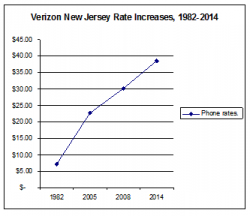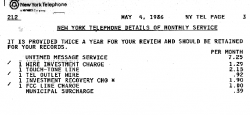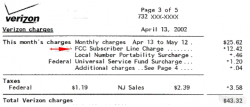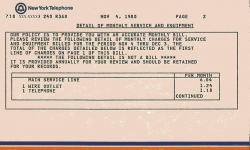SEE THE VIDEO: (Shot by Joly MacFie).
Bruce Kushnick, Executive Director, New Networks Institute, talks about
The Book of Broken Promises: $400 Million Broadband Scandal & Free the Net
@civichall, April 28th, 2015
The Book of Broken Promises Resource Page,
Available as a Paperback, Kindle or PDF
Table of Contents, About the Author, Fact Sheet, About the Trilogy
SLIDE PRESENTATION BELOW: PDF
New Networks Institute Activities, 2013-2015
New Networks Institute & Teletruth Activities, 2013-2015
Net Neutrality and Verizon’s Use of Title II
- New Networks Institute’s (NNI) work in highlighted in the FCC’s Internet Order, and influenced some of new added safeguards pertaining to billing and disclosure issues, March 2015.
- NNI & Teletruth have filed a Petition for the FCC to investigate whether Verizon has committed perjury as Verizon has failed to disclose to the FCC, courts or public that their entire financial investments are based on Title II; filed January 13th, 2015.
- Ars Technica Featured article: FCC urged to investigate Verizon’s “two-faced” statements on utility rules
- Verizon has responded with a letter denying our claims, filed, January 20th, 2015
- New Networks Institute & Teletruth Response to Verizon, Feb 23rd, 2015
- Verizon: Show Us the Money PART I: Verizon’s FiOS, Fiber Optic Investments, and Title I. – Part 1 is a supplement to the original Petition for Investigation.
- Letter to the FCC, Comments: Open Internet proceeding. RE: Verizon’s Fiber Optic Networks are “Title II” — Here’s What the FCC Should Do. DOCKET: Open Internet Proceeding, (GN No.14-28)
- Comments First: FCC Open Internet Proceeding “Title Shopping: Solving Net Neutrality Requires Investigations” , July 14th, 2014
- Comment Second: Verizon’s FiOS Fiber to the Premise (FTTP) Networks are Already Title II in Massachusetts, Maryland, Florida, New Jersey, District of Columbia, Pennsylvania, New York…
Time Warner Cable- Comcast Merger; New Findings
- Comcast and Time Warner Cable Merger In 2015 we filed a Petition for Investigation and Complaint against Time Warner Cable with the NYPSC and FCC to stop the mergers for multiple reasons, from deceptive billing and made up fees, to overcharging via the “Social Contract”. The “Social Contract”, an actual agreement between the cable companies and the FCC, allowed the companies to charge the cable subscribers for network upgrades and the wiring of the schools. The Contract ended in 2001, however we could find no schools wired under this program, and no removal of the additional charge of $5.00 a month, which started in the 1990’s.
- Some of this material was quoted in Mayor DeBlasio’s comments pertaining to the TWC Comcast merger with the NY PSC.
- Ars Technica article: Petition: Time Warner Cable mistreats customers, shouldn’t merge with Comcast
Examining the Financial Shell Game
- In May 2014, Public Utility Law Project, (PULP) published “It’s all Interconnected”, written by New Networks (with assistance by David Bergmann) and it relied on unexamined data from Verizon New York using different Verizon supplied financials books.
- The Verge: Game of Phones: How Verizon is playing the FCC and its customers, May 2014
- In 2010, NNI started an investigation of the financial books of five Verizon’s state-based utility phone companies, including Verizon New York and Verizon New Jersey and the ties to Verizon Communications affiliate companies, (subsidiaries) including Verizon Wireless, Verizon Online, Verizon Services, among others.Published in 2012
- In 2013, our next report focused on Verizon New York and was the centerpiece of a filing by Common Cause, Consumer Union, CWA, and the Fire Island Association, which called for an investigation of Verizon’s financials and business practices.
- The Connect New York Coalition, filed a Petition with the New York State Public Service Commission to do a formal investigation of Verizon New York. July 1, 2014. The Petition is based, in part, on NNI’s continuing research.
- Coalition members include AARP, Consumer Union, Common Cause, CWA, and NY state politicians.
- Event “Reverse ALEC Legal Hackathon” Thursday, January 31st, 2013, Brooklyn Law Incubator and Policy Clinic (BLIP) and the New Networks Institute hosted a Reverse ALEC Legal Hackathon at Brooklyn Law School. The invitation-only event, something of an emergency meetup, brought together experts, lawyers, advocates, technologists and competitors, who are concerned with the state of telecommunications in the United States. The goal was to create consensus and build a campaign to define principles for model regulation, pursue legal actions, and create a working path to accomplish the following goals.
- New Book: The Book of Broken Promises: $400 Billion Broadband Scandal & Free the Net, Published New Networks Institute, February 2015.
Verizon New Jersey Local Service Increases, 1982-2014 — 440%.
Verizon New Jersey and the NJ Board of Public Utilities have created a deal to erase Verizon’s obligations that require the company to upgrade 100% of their territory, replacing the aging copper wire with a fiber optic wire, offering speeds of 45 Mbps or better in both directions by 2010. Customers where charged about $15 billion extra since 1993 for these upgrades.
Verizon filed comments as part of this proceeding and claims that the company had no rate increases from 1985 through 2008. Verizon Stipulation Agreement filing, March 24, 2014:
“In fact, the regulatory plan adopted with Opportunity New Jersey allowed a modest amount of pricing flexibility for certain services while imposing a price cap that resulted in Verizon not increasing the price for basic phone service in New Jersey for twenty-three years (between 1985 and 2008)”.
And in an Ars Technica article, Verizon spokesperson Lee Gierczynski said the 1993 agreement “imposed a price cap on basic phone service that resulted in no increases in that service from 1985 to 2008.”— You got to be kidding me.
Verizon’s Deceptive Math: Take Out a Bag of M&M’s and Only Count the Yellow Ones.
In 2008, we filed comments with the NJBPU as part of a proceeding to raise Verizon’s phone rates. Verizon had made an almost identical statement seven years ago and at the time we went through actual Verizon phone bills and found that local phone service had increased a whopping 300%-350%. And continuing this analysis, by the end of 2013, the company had raised local service about 440% — or more depending on what you count.
 But, you don’t have take my word for it. Let’s go through actual charges taken off Verizon’s phone bills. We will attempt to make this as painless as possible as no one can read their bills — they were designed that way.
But, you don’t have take my word for it. Let’s go through actual charges taken off Verizon’s phone bills. We will attempt to make this as painless as possible as no one can read their bills — they were designed that way.
Verizon Didn’t Count 1: The FCC Line Charge is on Every Local Phone Bill.
This is a Verizon New Jersey bill from April 2002 that is paying for 2 lines. And it has an “FCC Subscriber Line Charge”, which was $6.21 cents per line. Verizon’s quote doesn’t include this charge in their analysis of no increases between 1985 to 2008.
The FCC Line Charge (it has many different names), is on every local phone bill and the charge started in 1985. You can’t get service without paying this charge and the money does NOT go to fund the FCC but is direct revenue to Verizon New Jersey.
Moreover, the New Jersey State law details that this “Federally mandated subscriber line charge” is part of local service: N.J.A.C. 14:3 – 7.17 (a):
“’Basic residential local telephone charges’ include charges for basic residential local telephone service, basic residential local service usage, nonrecurring charges for basic services (service ordering charges and installation charges for basic services), the Federally mandated subscriber line charges, and applicable State and Federal taxes.”
And yet, Verizon leaves off this charge.
Then we have the taxes, fees and surcharges that are applied to the FCC Line Charge. On the bill you will notice Verizon applies a “Federal Universal Service Fund Charge” (FUSF) as well as Federal and state taxes. In 2002, the Universal Service Fund was an 11.4% tax applied on all ‘interstate’ telecommunications services and because the FCC Line Charge is considered Federal it gets taxed FUSF. (Caveats: These charges can vary throughout the year. The FCC Line Charge increased from $1.00 in 1985 to a cap of $6.50 per line per month by 2003. The FUSF has had varying rates through this period. It was 5.5% in 2000, the first year, by 2008 it was 11.4% and most recently it was 16.4% tax, applied to any ‘interstate service’. And yes, they got the tax on this bill.)
Verizon, of course, will make excuses. Oh, but the FCC Line Charge is “interstate” and Federal vs controlled by the State Commission
Also, on this bill is also something called a “Portability” charge, which is more revenue to Verizon.
Add up the ‘Total Monthly Charges” for 2 phone lines— It’s ugly. While the cost of the ‘monthly charges’ was $25.62, there’s an additional $17.70 cents — 70%. I thought that Verizon said there was no ‘increases’.
Let us be clear. You pay a local service bill. It has charges on it that you must pay and you can’t get service without it. If Verizon doesn’t want to count these charges, then why shouldn’t the customer have the right to not pay what’s not being counted?
But we’re just getting started… The problem of not counting multiple charges on the bill almost rises to one of the biblical afflictions, like locusts or floods.
Anyone who has ever bought a bundled package of services from Verizon (or the other phone or cable companies) knows that they all play this shell game; the price of service you have to pay is always 10-40% more than the advertised price. That’s because the companies leave out the cost of all of these ancillary charges and taxes in their sale pitch.
Verizon Didn’t Count 2: “Local Service” was a “Bundled” Service.
In 1982, New Jersey Bell’s (now-Verizon New Jersey) local phone service was a bundled service and it came with unlimited local calling, unlimited directory assistance, the wire in the home and the phone rental.
This next antique bill is from New York Telephone in 1980 and it is similar, if not identical to a New Jersey Bell phone bill from that time. It shows that local service was a total of $8.46, but that included the wire in the home for $1.24 called “wire outlet”, a phone rental fee at $1.18 as well as the main service line (sometimes called “dialtone”) for a total of $8.46, not counting taxes.
(NOTE: This page was only provided ‘annually’, so unless you had an interest, you’d never know that there were separate charges for these items.)
But, in 1982, prior to the break up of AT&T in 1984, there was a deregulation where the phone rental and the inside wire (which became “inside wire maintenance” fee) were spun off — and each charge would then be able to increase. The phone rental went to AT&T, while the inside wiring was kept in Verizon New Jersey. This deregulation was done so that customers could buy their own phones or not pay for the maintaining the wire in their home.
Verizon New Jersey picked the year 1985 to avoid the truth about what happened to local service rates.
First, the companies were able to still keep the total cost of local service the same, even though it should have been lowered as the component parts were no longer included; i.e., if local service came with the inside wire, then that expense, which was $1.24, should have been deducted from the total cost moving forward. It wasn’t.
While the price stayed the same, you now got less for your money.
But that’s only part of this tale. From 1982-1985 they added a number of extra charges. This next New York Telephone bill from 1986 shows an inside wiring fee, (which went down a bit to $.92 cents) as well as an additional, but related ‘wire investment charge’ of $1.29. For the phone rental, there was the phone rental charge, as well as an additional “investment recovery charge” of $1.90. New Jersey went through an identical process.
 But the kicker is that in 1985, about 90% of all customers still paid for inside wiring and about 75% were still renting the phone, (which went up to $3.18 a month by 1986 from $1.18 a month in 1980, not counting the additional charge).
But the kicker is that in 1985, about 90% of all customers still paid for inside wiring and about 75% were still renting the phone, (which went up to $3.18 a month by 1986 from $1.18 a month in 1980, not counting the additional charge).
In 1985, then, the majority of customers were paying a) inside wire maintenance, b) a second charge for inside wire called ’wire investment’, c) a phone rental fee, d) an additional phone rental fee “investment recovery” and e) an inflated ‘basic service’ cost. (Notice that the FCC Line Charge was $1.00 in 1986.)
Thus, if we start with 1985, these other charges would have been part of ‘local service’, but Verizon, of course, never discussed this.
Verizon Didn’t Count 3: Inside Wire Maintenance Increases.
In our surveys of thousands of phone bills and interviews we found that at least half of those paying an inside wire maintenance fee didn’t order it and didn’t know it was on their bill as there is confusion from all of the terms sounding the same — inside wire, FCC subscriber line, dialtone line, etc.
However, this one Verizon New Jersey charge went from $.95 in 1982 (where it remained through the 1990’s) to $7.99 per month— A 741% increase. And by 2008, it had increased 364%, not counting the related taxes, fees, and surcharges.
There is no data about the number of customers who are paying for the service in 2014.
Verizon Didn’t Count 4: Directory Assistance Increases
Directory Assistance, i.e. calling ‘411”, was a free service as part of Verizon New Jersey’s ‘basic local service’. By 2008, the company removed most free calls, but kept an ‘allowance’ of four free calls per month in 2007, then reduced to two per month in 2008 with a charge of $1.50 after the allowance runs out, per call.
In 2008, when Verizon was asked how many customers use directory assistance and how many calls do they make a month, they sent this:
The NJ Rate Counsel claimed that the changes to service by Verizon eliminating these last remaining free calls would add $187 million in extra costs to customers.
“The 4 free Directory Assistance calls for residential customers could be eliminated and rates increased. Rate Counsel’s estimate is that elimination of free calls and rate increases for Directory Assistance could cost ratepayers another $187 million.”
The last records we found around 2008 showed that, with automation, it cost 15-25 cents to offer directory assistance per call.
To recap, we have a bundled service where every part is ‘deregulated’, prices continue to go up, and Verizon’s data claims that there have been no changes.
Verizon Didn’t Count 5, 6 & 7: Other Expenses/Increases Not Mentioned
There have been multiple changes to phone charges in New Jersey from 1985-2008 for residential and business services.
- Local Number Portability Surcharge — Throughout this period there was an additional $.23 charge per line per month, which was revenue to the companies for allowing you to take your number with you if you changed providers. It came to $18-$20 million dollars extra a year for the company.
- E911 — $.90 a month was added for emergency services and it is a profit center for Verizon. In 1991, then-New Jersey Bell showed a $13 million revenue increase from providing E911 services. It is clear that it was not up for bid and we could not find any more recent information about revenues in Verizon’s SEC filings.
- 4/16/05 — Merged “Calling Areas”. Verizon merged four differently priced residential calling areas. The ‘cheapest area’ had a 15% increase.
- 4/16/05 — Verizon New Jersey had a $.65 cent credit on residential and small business phone bills which was eliminated in 2005. *Impact: Removing the $.65 cent credit yielded over $23 million annually in new profits. We are not sure when this credit was added to the bills.
- 1/01/07 — The optional wire maintenance plan went from $4.25 up to $5.75.
Verizon Didn’t Count 8: Business Rate Increases.
We note: Verizon’s quote is only for residential services, it would appear, as there were increases for small businesses.
- 8/16/03 — Verizon NJ (VNJ) eliminated the small business discount of $1.01/month on auxiliary (i.e., a second line or more) business lines associated with accounts with 2-4 lines. * Impact: Auxiliary business lines for small businesses with less than 5 lines went up approximately 10%.
- 11/01/06 — VNJ hiked statewide rates for multi-line business customers and introduced 2-year term plan.
- 2/01/07 —VNJ raised rates again. This was the second rate hike in 3 months, from $16 to $17, auxiliary business lines increased from $12 to $13.
Verizon Didn’t Count 9: Post 2008: Just Some of the Increases
Starting in 2008, local residential service went go up 79%; Business services were up about 70%. Caller ID went up 38%, while non-published number rose 68%. Caller ID has profit margin of 5695% and a non-published number has a 36,900% profit margin. (The ‘costs’ listed were from a 1999 Florida Public Utility Commissioner report. It is obviously cheaper to offer these services in 2014.)
And there have been more increases to some of these services since 2008.
Total Local Service: Over 440% and Counting
By the end of 2013, if you just kept the same local service since 1982, you were paying about 440% more (not counting the phone rental).
 Signs of a Monopoly: How Can Prices Go Up if there’s Competition?
Signs of a Monopoly: How Can Prices Go Up if there’s Competition?
Prices should have gone down, down, down. First, the copper networks have been written off—“fully depreciated”, so their value is nominal. Then they slowed down maintaining those wires over the last decade and more recently decline to repair the copper. And since Verizon cut staff over 70% since 1985, prices should have plummeted as the expenses were sliced. Also, there was supposed to be competition to lower prices further.
What about comparing this to the Consumer Price Index (CPI)? Why? The CPI is based on the assumption that the cost of goods goes up. Here, the cost of goods have been going down.
Bottom line: Prices didn’t remain ‘frozen’ from 1985 through 2008, much less after and it is clear that these extra fees were all part of the state’s deregulatory gifts to Verizon New Jersey. Problem is – these extra profits should have been used to upgrade the state infrastructure starting in 1993. Instead, they just increased the companies’ profits.
NOTE: Tom Allibone, president LTC Consulting, a New Jersey-based telecommunications auditing firm, worked on the analysis of the phone charges.




